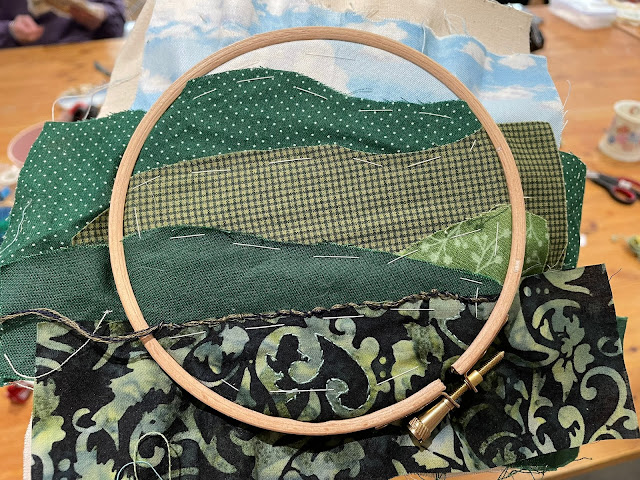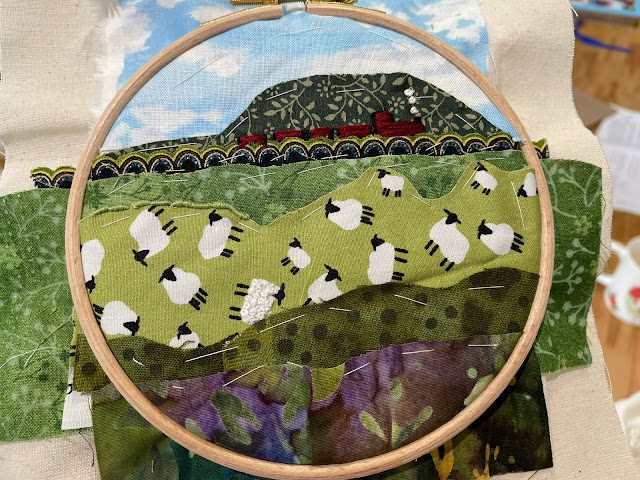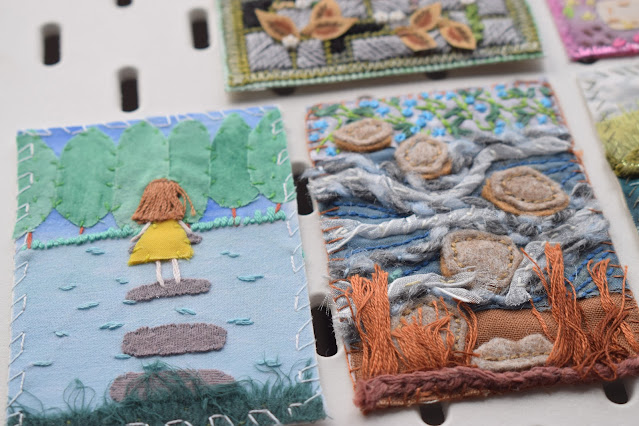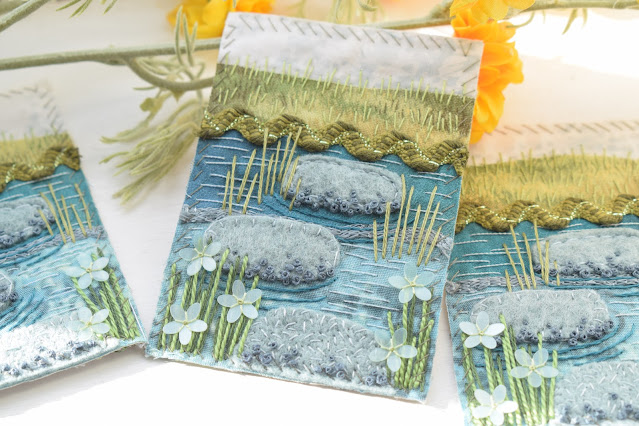Continuing with my new idea of naming Stitchscapes after random place names in the UK, this one is being called Boggy Bottom!! And as soon as the name popped up on a Google search, I knew it had to be the one.
Oddly, having never before heard of the name of the previous similarly named Stitchscape,
Barton in the Beans, it cropped up on a radio show my Dad listens to where they try and guess which village has the earliest sunrise, or sunset. It was really odd and quite a coincidence! So we will have to see where Boggy Bottom might pop up next.
This piece started as a workshop demonstration piece, the initial story of which
you can read here, before being used as a bus project. It has been made using fabrics that are all available in my web shop (small plug there!
And bigger link here!) and I've also utilised the fluffy selvedge edges from the batik fabrics as a textured fabric edging on the water.
It's quite a quick and simple little piece, nothing particularly complicated about it and more embroidered as a way of keeping my hands busy whilst out and about on the commute. Embroidery is so mindful and relaxing, you can just be in the moment and not really have to think about anything other than what pops into your head. I do also use it to help me work through thoughts too if I've got a complicated problem, because you aren't stressing about whatever it is and usually a solution pings in after a while.
The lovely yellow linear fabric has a beautiful horizontal striping to it and I've just followed this with a single strand of back stitch worked in two different colours to emulate a setting sky with its washy streaks. The same two colours have been used in the needle at the same time to create two strand bullion knots on the fabric edge.
There's a lot of difference in the colours here from when it's sunny or not - either that or there's a bigger change between a phone camera and a proper camera but the next few photos were taken on an overcast, drizzly day but with a better camera and the colours look much cooler.
My top green mountain layer has been textured by padding out all of the blobby shapes in the batik print with satin stitch, and I've used three different colours of green for the blobs - partly to use up odds and ends of threads, and partly because I didn't have quite the right green in my travel pack at the time. It is more exciting though than just having the whole layer the same colour so in a way I'm glad that some boundaries were pushed by just having a go and seeing if the colours worked or not. If they don't there's no harm in just unpicking!
The layer has been edged by couching two colours of embroidery thread together and trying to keep the edging quite puffy, so I wasn't pulling on the threads as they were couched. Each individual thread was also separated before being loosely put back together so that any twists were removed and they would lie next to each other.

I've done quite a bit of couching in this piece as the next layer down as also been edged with couched embroidery threads. This time all the same colour and with slightly less thread. The batik print on this layer is really busy and I toyed with the idea of filling in every single dot but I think ultimately it would have been way too much! Instead I have gone around the larger spots with a single strand of back stitch, then chosen a few lines of the printed spotted lines to fill with french knots. I think it looks quite cool actually, and the lighter green colour stands out but doesn't look completely odd as it matches the pale, washed background on the batik in the centre. To me it's like an overgrown vineyard with some of the rows of vines still intact.
If you read my previous post about starting this piece, you'll know that when I cut the fabric layers up and tidied the edges, I saved the selvedge edges because they were just so beautifully fluffy! Everything about proper batik fabrics is lovely, the weight of it, the tightness of the weave (meaning less fraying, although slightly more difficult to stitch through), the patterns and colours, and the edges!
I combined the three batik selvedges together, layering them up and stitching them down one at a time. The blue went down first as I didn't want it to sit on the water's edge, more like a reflection further away, then the two greens. They've been stitched slightly lower down the hoop edge time so there is a staggered effect, and I've added yet more couched embroidery threads - using three colours this time-to the very edge of the fabric of the selvedge to hide the straight cut. These couched threads have been stitched down in exaggerated waves which sit up from the surface of the hoop and move around, much like plants on the bank of a river really would.

Over the top of this I have made straight stitch stems in two colours, adding pops of yellow, to balance with the yellow sky, as sets of three french knots to be a sort of reedy flower. Adding some glitz to the stems are these lovely little glass seed beads in an oily green that just catch the light and could be bubbles on the surface. Adding a small amount of sparkle somewhere really lifts an otherwise very matte piece.
The water has been almost crudely stitched, with single strand whipped running stitch (the running stitches and the whip stitches are two different colours), following the two lines of the edges. Between these lines I've made big running stitches in a single strand of metallic embroidery thread in pale blue for a little extra sparkle - although these possibly stand out more than I would like. I don't dislike it enough to pull them out though as again the paleness of them matches the paleness of the french knots in the layer above. I've also just noticed that I've missed some tacking stitches in the water so after finishing this post I'm just going to go and quickly pull those out!
The final stitch run down for this piece is; bullion knots, back stitch, couching, satin stitch, french knots, straight stitch, running stitch, whip stitch and beading.




















.jpg)
.jpg)




































